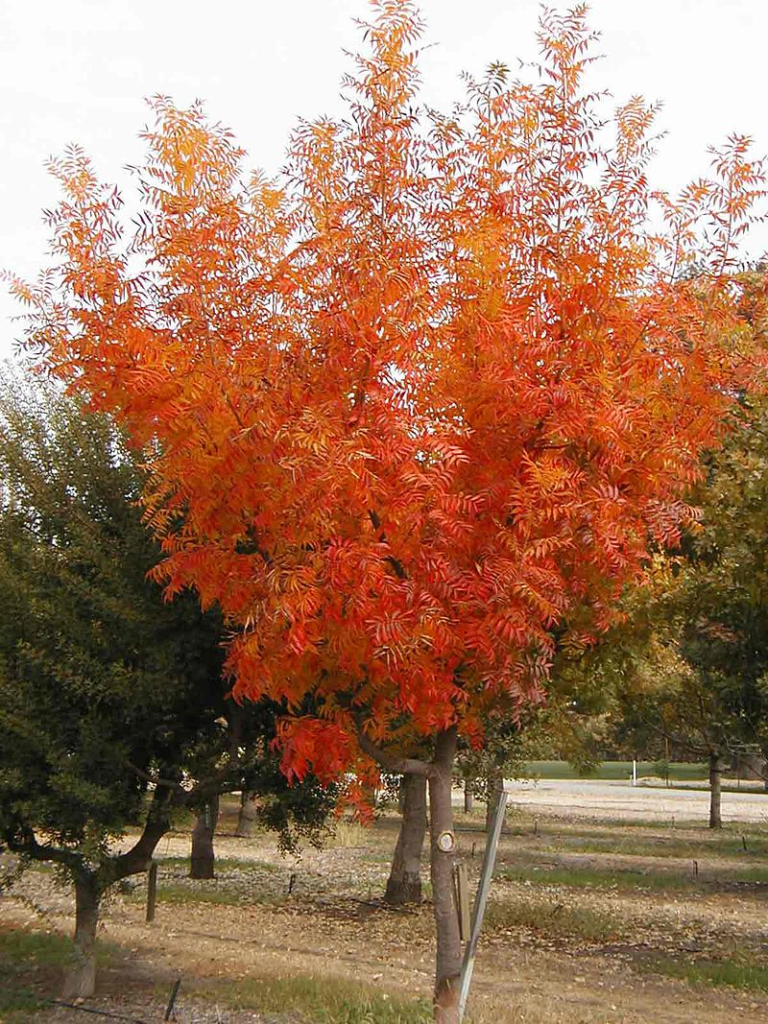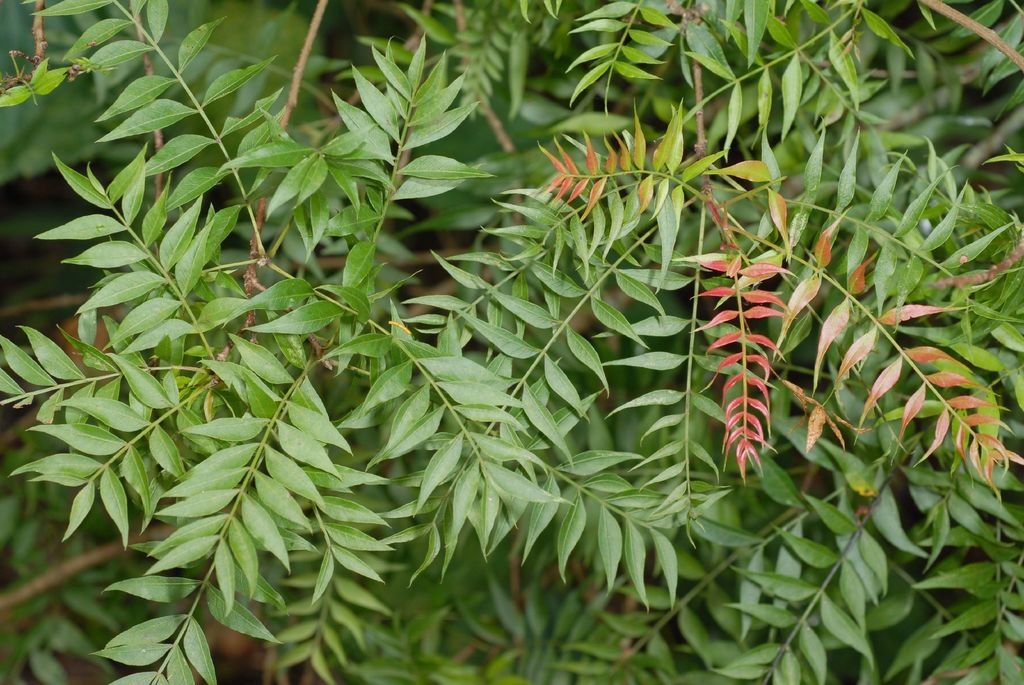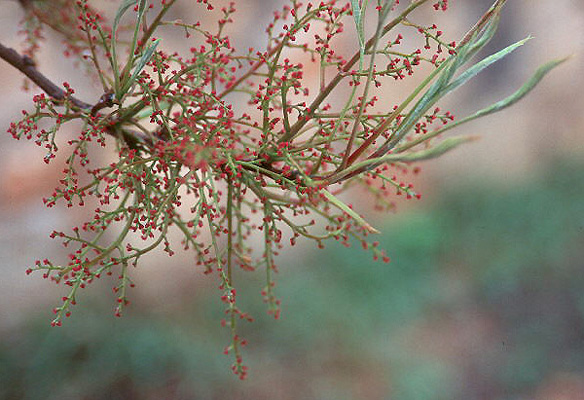Scientific name: Pistacia chinensis Bunge
Common name: Chinese pistache
Family: Anacardiaceae (Sumac family)
By Cheryl Fossum Graham
The Chinese pistache is native to central and western China and Taiwan. It is a member of the cashew family, Anacardiaceae. It can be found in a variety of Mediterranean climates. In the United States it is grown in the Southern states and along both the Pacific and Atlantic coasts, wherever the winters are mild followed by hot and dry summer conditions. Its native habitat consists of mountain and hill forests with rocky soils, which typically exist anywhere from 330 – 11,800 ft above sea level. In China it is valued as an ornamental tree planted in parking lots and along sidewalks. The seed is a source of biodiesel fuel and the wood is used for furniture as well as for its yellow dye.
The Chinese pistache is not only heat and drought resistant, but it is also winter hardy, as it can withstand temperatures as low as 20°F (-6°C)—probably lower as it has become a popular tree in Albuquerque and is starting to be seen in Santa Fe. It is tolerant to a wide variety of soil types, such as clay, loam, sand, acidic, and alkaline soils. Although this tree can survive in many different environments, it should receive a minimum of six hours of unfiltered sunlight per day. Its roots are non-invasive and grow deep, making this the ideal tree for lining sidewalks, patios, and structures. This tree is resistant to fire and pests; however, it is susceptible to Verticillium wilt, which is why it should be planted in well-drained soils.
 Pistacia chinensis. Public Domain, https://commons.wikimedia.org/w/index.php?curid=610482 |
Family: Anacardiaceae
Genus: Pistacia Leaf: Dark green, compound leaf with 10 – 12 inch leaflets that release a pleasant scent when pressed Bark: The outer bark, a grayish brown, peels easily to expose a reddish interior Seed: Inedible Blossoms: The green flowers bloom in April and May Fruit: A small red drupe that turns blue when ripe Native Habitat: Central and Western China Height: 25 – 35 Feet Canopy: 25 – 35 Feet Type: Deciduous Native Growing Zone: Rocky environments and mountain forests USDA Hardiness Zone: 6a, 6b, 7a, 7b, 8a, 8b, 9a, 9b |
|---|
Leaves
The Chinese pistache has an alternate arrangement of pinnately compound deciduous leaves, which means that multiple leaflets are attached to several places along the main shaft. Although these numbers vary, the typical Chinese pistache leaf is one foot long and consists of 10-16 leaflets that range from two to four inches in length.
Chinese pistache leaves are slightly aromatic and can release a subtle fragrance when punctured or bruised. These leaves display an attractive, dark green color throughout summer. As fall approaches, the color of the foliage transitions towards a vibrant mixture of orange-red leaves, which gives rise to its autumnal brilliance. It is one of the last trees to change colors in the fall, and thus carries over its autumn colors into early winter. It’s in the same family as the native sumacs of the US, which are well known for their similarly brilliant fall colors.

Credit: R&B Floridaseeds. https://floridaseeds.net/
Flowers, Fruits and Seeds
Chinese pistache flowers are red in color and are showy during the spring season. These flowering plants are dioecious, meaning that the male and female reproductive organs exist in separate trees. Female Chinese pistache trees can produce clusters of ornamental fruits whenever a male tree is close by. These fruits are classified as drupes, since they consist of a fleshy outer skin that surrounds a single pistachio-type seed. The berries are bright pink-red in color during the fall, but they turn a purple-red color as winter approaches. The seeds are not edible for humans, but they are a source of food for birds and small animals. The seed of the Chinese pistache has a high oil content and, as mentioned above, is a source of biofuel in China. The oil also contains tannin, which is a natural pesticide for the tree, but can be extracted as an intermediate chemical for drug manufacturing.

Credit: Oregon State University, Department of Horticulture. https://landscapeplants.oregonstate.edu/
Medicinal Uses
The oil of the Chinese pistache is not the only practical product of this tree. Galls, or abnormal growths, have medical applications as an astringent, expectorant, analgesic and anti-inflammatory. They are used in Ayurvedic medicine to treat respiratory disorders.
Extracts from the tree bark have been shown to have antioxidant properties in certain lung and thyroid injuries.
In Pakistan, it is used to treat hepatitis and liver disorders. In traditional Chinese medicine, parts of the plant have been used to treat dysentery, inflammatory swelling, psoriasis, and rheumatism.
Invasive Risk Assessment
In 2012 the Animal and Plant Health Inspection Service of the US Department of Agriculture issued a weed risk assessment on the invasive risk potential of the Chinese pistache. At the time of the report the tree was known to have naturalized and was spreading in North Carolina and Australia raising concerns about unwanted spreading in the other states where it was naturalized, including New Mexico. The main factors influencing the risk assessment were wind pollination and seed dispersal by birds and animals. Using a validated risk assessment model, the invasive risk for Chinese pistache was considered low; however, based on experience with other trees where seed dispersal by birds and small animals have resulted in crowding out native species, the final risk assessment was considered high. There was no evidence at the time of the report in 2012 that actual invasive behavior had occurred with the Chinese pistache either in the US or in Australia. The report concluded that “Because this species is in the nursery trade and is a fairly popular landscape plant, encouraging purchases of the seedless cultivar may help minimize any negative impacts.”
Sources
- “Chinese pistache”. Garden Explorer. Santa Fe Botanical Garden. Web. 14 Nov 2023. Retrieved from: https://santafebotanicalgarden.gardenexplorer.org/taxon-1346.aspx?qr=0
- “Chinese pistache”. iNaturalist. Web. 14 Nov 2023. Retrieved from: https://www.inaturalist.org/guide_taxa/1604028
- “Chinese pistache”. University of Redlands. Web. 14 Nov 2023. Retrieved from: https://sites.redlands.edu/trees/species-accounts/chinese-pistache/
- Guo, H.; Liu, Y.; Wang, H.; Li, S. Study on the Dormancy Characteristics of Chinese Pistache (Pistacia chinensis Bunge) Seeds. Forests 2022, 13, 1521. https://doi.org/10.3390/f13091521
- Hoang, D. “Tree Spotlight: Chinese Pistache”. Canopy. Web. 14 Nov 2023. Retrieved from: https://canopy.org/blog/tree-spotlight-chinese-pistache/
- “Weed Risk Assessment for Pistacia chinensis Bunge (Anacardiaceae) – Chinese pistache”. USDA. Web. 14 Nov 2023. Retrieved from: https://www.aphis.usda.gov/plant_health/plant_pest_info/weeds/downloads/wra/Pistacia_chinensis_WRA.pdf


